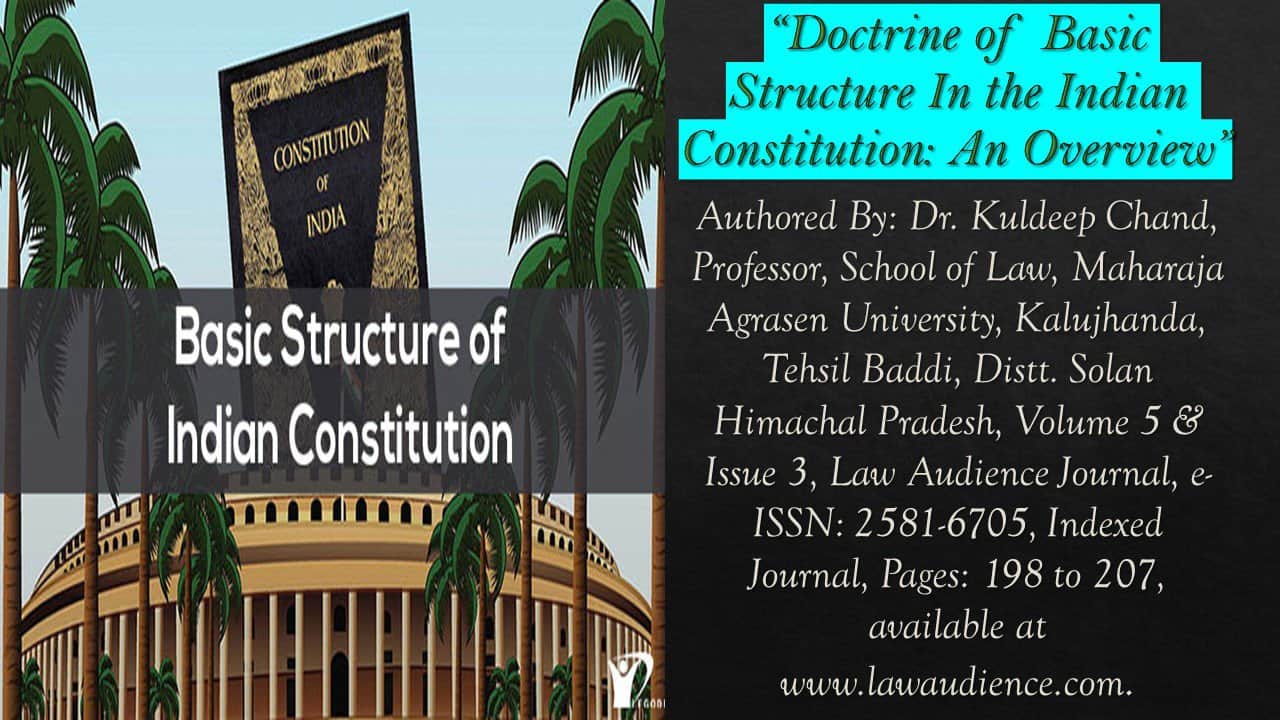Click here to download the full paper (PDF)
Authored By: Dr. Kuldeep Chand, Professor, School of Law, Maharaja Agrasen University, Kalujhanda, Tehsil Baddi, Distt. Solan Himachal Pradesh,
Click here for Copyright Policy.
ABSTRACT:
“The Constitution of India is the supreme law of the land. It covers almost all aspects related to law-making for the country, making it one of the lengthiest written constitutions in the world. Consequently, several amendments since its adoption have taken place, to keep it at pace with the ever-changing Indian society. But being the supreme law that it is, it also has to maintain its basic ideologies intact and preserve them from alteration, because they incorporate the vision that our Constitution makers set forth after independence. These basic ideologies, sometimes referred to as the “basic structure” of the Constitution, have often faced attacks from various sources. As of now, the picture is clear, especially after the Kesavananda Bharati’verdict. But what all led to the case, and how the basic structure of the Constitution finally came to be as an inalienable part, is an important discussion for every law student and legal professional. The doctrine of basic structure is one such doctrine which states that certain characteristics of the constitution of a sovereign state cannot be erased or altered by the legislature of the state. Although it is a common law doctrine, it was developed by the Supreme Court of India in the case of Kesavanada Bharathi vs State of kerala. The aim of the doctrine is to strike down any law or any constitutional amendment that in any way alters or eradicates the basic structure of the Constitution. The Constitution makers gave the power to amend the Constitution in the hands of the Parliament by making it neither too rigid nor too flexible with a purpose that the Parliament will amend it as to cope up with the changing needs and demands of “we the people”. The Parliament in exercise of its constituent power under Article 368 of the Indian Constitution can amend any of the provisions of the Constitution and this power empowers the Parliament to amend even Article 368 itself”.
Keyword: Doctrine of Basic Structure, Kesavananda Bharati ‘verdict, constitutional amendments, amending powers of Parliament. Landmark Judgements.
I. INTRODUCTION:
The Constitution of India did not emerge from vacuum. It is a continuous process of evolution, reformation and recreating the existing system of governance by eminent scholars, experts, and judges etc. No Constitution can remain static. It must respond to new challenges and take account of unanticipated and unforeseen events which were not within the contemplation of the framers of the Constitution. Parliament in its constituent power can amend by way of addition, alteration, variation or repeal any provisions of the Constitution. On its plain terms Art.368 is plenary and is not subject to any limitations or exceptions. Bringing alteration to the Constitution provisions by the Parliament was very easy process before Keshavananda Bharathi’s Case[1] because there was no implied or express limitation on its amending power exercised under the Constitution.[2] But in the Keshavanandha’s case, uncontrolled power of the Parliament has been controlled and curtailed by the Doctrine of Basic Structure.
This Doctrine conceived in the case of Sajjan Singh[3] and took real birth in the case of Keshavanandha Bharath’s Case[4]. It is the product of the long struggle between the Judiciary and Parliament. Through this basic structure principle, the Supreme Court changed the course of Constitutional history by denying the assertion of supremacy of Parliament in matter of amending the Constitution at solely on the basis of requisite voting strength, quite unmindful of the basic or fundamental rights of citizens.[5] Art.31-B and Ninth Schedule[6] are the main root cause for developing this doctrine by the Judiciary in so many cases. The reason is, this Schedule made controlled Constitution into uncontrolled by excluding the judicial review which is also a form part of the Basic Structure.
II. DEVELOPMENT OF BASIC STRUCTURE THEORY IN PRE KESHAVANANDA’S CASE:
After independence, the Government of India started to implement agrarian reforms scheme, but unfortunately, this action of the government was attacked and challenged in many High Courts, because the initiation of agrarian reforms was directly violating the Fundamental Right such as Arts.14, 19 and 31, especially right to property which was a fundamental right in the original constitution. The question whether Fundamental Rights can be amended under Art.368 came for consideration in the Supreme Court in Shankari Prasad case.[7] In this case validity of Constitution (First Amendment) Act, 1951 which inserted inter alia, Arts.31-A and 31-B of the Constitution were also challenged. The amendment was challenged on the grounds that it abridges the rights conferred under Art.13 of Part III and hence was void. The Supreme Court however rejected the above argument and brought out the distinction between legislative power and constituent power and held that “law” in Art.13 did not include an amendment of the Constitution made in the exercise of constituent power and Fundamental Rights were not outside the scope of amending power.[8] In Golak Nath case[9], the validity of 17th Amendment which inserted certain Acts in Ninth Schedule was once again challenged. The Supreme Court ruled that the Parliament had no power to amend Part III of the Constitution and overruled its earlier decision in Shankari Prasad[10] and Sajjan Singh case[11]. In order to remove difficulties created by the decision of Supreme Court in Golak Nath’s case[12] the Parliament enacted the 24th Amendment Act. In Keshavanandha Bharathi Case[13] an attempt was made to question the plenary power of the Parliament to abridge or take away the Fundamental Rights, if it was necessary by the way of amendment under Art.368 of the Constitution. Seven out of the thirteen judges Bench held that the Parliament’s constituent power under Art.368 was constrained by the inviolability of the Basic Structure of the Constitution, which was one of the Basic features of the Constitution. The Basic Structure of the Constitution could not be destroyed or altered beyond recognition by a constitutional amendment[14].
The Supreme Court recognized Basic Structure concept for the first time in the historic Kesavananda Bharati[15] case in 1973. Ever since the Supreme Court has been the interpreter of the Constitution and the arbiter of all amendments made by Parliament. In this case the validity of the Twenty -fifth Amendment Act was challenged along with the Twenty-fourth and Twenty-ninth Amendments. The Court by majority overruled the Golak Nath’ case which denied the Parliament’s power to amend Fundamental Rights of the citizens. The majority held that Art.368 even before the 24th Amendment contained the power as well as the procedure of amendment. The Supreme Court declared that Art.368 did not enable the Parliament to alter the basic structure or framework of the Constitution and Parliament could not use its amending power under Art.368 to ‘damage’, ’emasculate’, ‘destroy’, ‘abrogate’, ‘change’ or ‘alter’ the ‘basic structure’ or framework of the Constitution. This is how the development of this Basic Structure Doctrine evolved because of some controversy that was found in the laws included in the Ninth Schedule.
III. BASIC STRUCTURE IN POST KESHAVANANDA’S CASE:
After Keshavananda Bharathi’s case[16], Supreme Court in many cases invoked this Doctrine of Basic Structure. The Doctrine of non-amendability of the basic features of the Constitution implies that there are certain provisions in the Constitution which cannot be amended even by the following prescribed procedure there for. There is no exact list of as to what these basic features are[17]. The Supreme Court has also not provided any such exhaustive list of the basic features of the Constitution, though some of the basic features have been highlighted in various judgements of Supreme Court such as Indira Nehru Gandhi case,[18] Minerva Mills case, [19]Waman Rao case [20] and I.R.Coelho case [21] etc. In these cases, many subject matters have been included under the principle of basic structure. This doctrine has got much importance after April 1973.
IV. FORTY-SECOND AMENDMENT AND BASIC STRUCTURE:
After the decisions of the Supreme Court in Keshavnand Bharati[22] and Indira Gandhi[23] cases, the Constitution (42nd Amendment) Act, 1976, was passed which added two new clauses to Art.368 of the Constitution expressly prohibiting the review of the Constitutional amendments. The 42nd Amendment tried to overreach the implication of Kesavananda Bharathi’s case. Clause (4) Art.368 stipulated that “No constitutional amendment (including the provision of Part III) or purporting to have been made under Art.368 whether before or after the commencement of the Constitution (42nd Amendment) Act, 1976 shall be called in any court on any ground.” Therefore, in India, as of 1976, the Supreme Court was precluded from reviewing constitutionality of Constitutional amendments. There is no doubt on this issue because clause (4) of Art.368 explicitly prohibits the judicial review of constitutional amendments. But in Minerva Mills Ltd. v. Union of India [24], question arose that, whether the amendments introduced by Sections 4 and 55 of the Constitution (42nd Amendment) Act, 1976 damage the basic structure of the Constitution by destroying any of its basic features or essential elements? The Supreme Court in its answer considered clause (4) and (5) of Art.368 that were inserted by the 42nd Amendment and held them to be unconstitutional since they damage and destroy the basic structure of the Constitution.
V. BASIC STRUCTURE AND JUDICIAL REVIEW:
A good Constitution always provides for the power of judicial review over the Constitutional amendments and legislative Acts.[25]The core concern of the Basic Structure is the ‘Judicial Review’, which is its integral or inseparable part. In this sense, without judicial review, the Doctrine of Basic Structure is simply inoperable or nonfunctional. That is by taking away the component of judicial review, we would be denying the very existence of the doctrine of the basic structure which is simply impermissible.[26]Art.31-B confers uncontrolled power on the Parliament by excluding judicial review in the exercise of its amending power. Art.31-B confers uncontrolled power on the Parliament by excluding judicial review in the exercise of its amending power. Such a scope has been given to Art.31-B for the purpose of promoting agrarian reforms in order to establish an egalitarian society. But unlike Arts.31-A and 31-C, Art.31-B has no definite criterion and Parliament under this Article has the power to confer ‘fictional immunity’ on the laws passed by it. Whereas Art.31-A and C have specific standards which do not affect or violate the basic structure. Art.31-A excludes judicial review of certain laws from the application of Arts.14 and 19. It does not exclude un- catalogued number of laws from the challenge on the basis of Part III. It is for this reason; the provisions of Art.31-A have been held to be not violative of the Basic Structure.
VI. BASIC STRUCTURE AND ARTICLE 31-B READ WITH NINTH SCHEDULE:
The very important issue that needs to be discussed here is whether Art.31-B read with Ninth Schedule violates Basic Structure or not? Since the land reform legislations directly impinged upon the Fundamental Right to property of the big landlords, this right proved to be the biggest obstacle in implementing land reforms. Such an obstacle was removed through the incorporation of Art.31-B along with Ninth Schedule by the very first amendment of the Constitution. Thus, speaking truly and contextually, the singular objective “behind Art.31-B is to remove difficulties and not obliterate part III in its entirety or judicial review.[27] The objective was essentially to accelerate the process of land reforms. In Shankari Prasad case[28], the first amendment was upheld as constitutional, because seemingly it was designed to provide “restricted immunity” of Fundamental Rights “only to protect a limited number of laws.[29] Initially 13 laws were placed to the Ninth Schedule- all relating to land reforms. But, in subsequent development, Ninth Schedule has become constitutional dustbin in the hands of Indira Gandhi and later government by allowing controversial laws into the Schedule. It is unfortunate to observe that the laws included in the Ninth Schedule are no longer restricted to those enacted to further agrarian and land reforms.[30]
VII. CRITIQUES OF DOCTRINE OF BASIC STRUCTURE:
The doctrine of “basic structure of the Constitution”[31]is very controversial. This doctrine does not have a textual basis. We do not find a provision stipulating that this Constitution has a basic structure and that this structure is beyond the competence of amending power. Therefore, the limitation of the amending power through the basic structure of the Constitution is deprived of positive legal validity. Moreover, not having its origin in the text of the Constitution, the concept of the “basic structure of the Constitution” cannot be defined. What constituted the basic structure of the Constitution? Which principles are or not included in this concept? An objective and unanimous answer cannot be given to this question. Indeed, in the Kesavananda Bharati’s case, the majority of judges who admitted the existence a “basic structure of the Constitution” did not agree with the list of the principles included in this concept. Each judge drew a different list. Each judge is able to define the basic structure concept according to his own subjective satisfaction. This leads to the fact that the validity or invalidity of the Constitution Amendment lies on the personal preference of each judge. In the event of this, the judges will acquire the power to amend the Constitution, not specifically conferred to them under the Constitution but given to the Parliament under Art.368 of the Constitution. Another criticism against the basic structure is that an amendment to a constitution may be necessary even to change the original intention of the Constitution framers, which may not suit a subsequent generation which is to work with the Constitution. Therefore, to hold that an amendment not falling in the line with the original intention of the founding fathers is not valid, does not seem to be a sound view[32]. The necessity of amending the Constitution to meet the needs of a changing society cannot be denied. This may even include changes in the basic scheme of the Constitution itself. One of the important critiques is that, if the basic structure theory was upheld, “every amendment made by the Parliament would be subject to judicial approval on the question whether it damages the core of an essential feature or not… and it is up to the Supreme Court and High Courts either to validate or invalidate the amendment. It is a step towards the ‘Government of Judges’ as the final say rests with the judges of the Supreme Court not with the Parliament.
If we argue in favour of the basic structure doctrine, we can arrive at some findings. Firstly, limitations sought to be imposed on various organs of the State are meant to prevent a movement towards authoritarianism. In Golak Nath’s[33] case it was pointed out that having regard to the history of our country, it could not implicitly believe the representative of the people, for uncontrolled and unrestrained power might lead to an authoritarian State. Secondly, The Supreme Court has had an occasion to show[34] that the probabilities have become actualities. Approving the Court’s decision striking down clause (4) and (5) of Art.329-A, it has been written that “it could be asked without straining one’s credulity too much, how this was concerned with advancement of the real purposes behind the Constitution”. If the representative bodies trusted with so much of power resort to constitutional amendments merely to facilitate persons in power, they can never be trusted with totality of constituent power and hence the need for and justification of the basic structure theory.
VIII. CONCLUSION:
At the initial stage of introducing the Ninth Schedule, the controversy was between the right to property and land reforms laws. Due to this incident the validity of a number of amendments made to the Constitution with respect to the Ninth Schedule were challenged in different cases. Of course, the attempt of Parliament to exclude the judicial review to question the laws placed in the Schedule are really appreciable since it was for bringing agrarian law reforms in the country and to protect the interest of land less, weaker sections of the society and speaking truly and contextually, the singular objective ‘behind Art.31-B is to remove difficulties and not to obliterate part III in its entirety or judicial review.[35] But in I.R.Coelho’s case Supreme Court held that, Art.31-B gives validation based on fictional immunity. In judging the validity of Constitutional amendment, we must be guided by the impact test i.e. Right Test. The basic structure doctrine requires the State to justify the degree of invasion of Fundamental Rights. The Parliament is presumed to legislate compatibly with the Fundamental Rights and this is where judicial review comes in. therefore it may be concluded that If framers had inserted express provision under Constitution of India regarding limitation of amending power of the Parliament under Art.368 itself, there would not have been a situation of introducing this basic structure doctrine and very importantly, if the Parliament had exercised its amending power without disturbing the Constitution’s supremacy in the case of Ninth Schedule, judiciary would not have made any attempt to propound the doctrine of basic structure even without express provisions of Constitution relating to limitation of amendment.
Cite this article as:
Dr. Kuldeep Chand, “Doctrine of Basic Structure in the Indian Constitution: An Overview”, Vol.5 & Issue 3, Law Audience Journal (e-ISSN: 2581-6705), Pages 198 to 207 (21st Nov 2023), available at https://www.lawaudience.com/doctrine-of-basic-structure-in-the-indian-constitution-an-overview.
References & Footnotes:
[1] Kesavananda Bharti v. State of Kerala AIR 1973 SC1461: (1973) 4 SCC.225
[2] Article 368 of the Constitution of India
[3] Sajjan Singh v. State of Rajasthan AIR, 1965 SC 845
[4] Supra n. 1
[5] Article on Basic Structure of the Indian Constitution : Doctrine of Constitutionally Controlled Governance ( From Kesavananda Bharti to I.R.Cohelho) by Virendra Kumar published in Journal of India Law Institute 2007, Vol-49, Jan –March, p.365
[6] Art.31-B read with Ninth Schedule Inserted in the Constitution First Amendment Act, 1951
[7] Sankari Prasad Singh v. Union of India, AIR 1951 SC 458
[8] The Court unanimously declared that the Constitution (1st Amendment) Act, 1951 was constitutional.
[9] Article 31-B: Validation of certain Acts and Regulations- Without prejudice to the generality of the provisions contained in Article 31-A, none of the Acts and Regulations specified in the Ninth Schedule nor any of the provisions thereof shall be deemed to be void, or ever to have become void, on the ground that such Act, Regulation or provision is inconsistent with, or takes away or abridges any of the rights conferred by any provisions of this Part, and notwithstanding any judgment, decree or order of any court or tribunal to the contrary, each of the said Acts and Regulations shall, subject to the power of any competent Legislature to repeal or amend it, continue in force.
[10] Supra n. 7
[11] Supra n. 3
[12] Golak Nath state of Punjab, (1967) 2 SCR 762: AIR 1967 SC
[13] Supra n. 1
[14] These Seven Judges were, Chief Justice Sikri, Justices Shelat, Hegde, Grover, Mukherjea, Jaganmohan Reddy, and Khanna. The minority consisting of Justices Ray, Mathew, Beg, Dwivedi, Palekar and Chandrachud held that Parliament had unlimited power of constitutional amendment. See S.P. Sathe, “Judicial Review in India: Limits and Policy”. H.M. Seervai, in his analysis of the case in his magnum opus, “Constitution of India” states that six of the seven majority judges held that there were implied and inherent limitations on the amending power of the Parliament, which precluded Parliament from amending the Basic Structure of the Constitution. However, Khanna J. rejected this theory of implied limitations but held that theBasic Structure could not be amended away. All Seven judges gave illustrations of what they considered Basic Structure comprised of.
[15] Ibid
[16] Supra n. 1
[17] Dr. Ashok Dhamija’s ‘Need to Amend a Constitution and Doctrine of Basic Features’ published by Wadhwa Nagpur, First Edition, revises 2007, p.341.
[18] Indira Nehru Gandhi v. Raj Narain, AIR 1975 SC, 2299 (1975) 3 SCC 34
[19] Minerva Mills v. Union of India AIR 1980 SC 1789
[20] Waman Rao v. Union of India, AIR 1981, SC271
[21] AIR, 2007 SC 861.
[22] Supra n. 1
[23] AIR 1975 SC 2299.
[24] (1981) 1 SCR 206: (AIR 1980 SC 1789)
[25] Dr. C.D. Jha’s ‘Judicial Review of Legislative Acts’, 2nd ed., 2009, p xxxiv.
[26] Supra n. 5
[27] I.R. Coelho v.State of Tamilnadu, AIR.2007 (1), at 890 (para 139)
[28] Sankari Prasad Singh v. Union of India, AIR 1951 SC 458
[29] See, Virendra Kumar’s article on Basic Strucutre of the Indian Constituion: Doctirne of Constitutionally Controlled Governaance (from keshavananda Bharathi to I.R. Cohelho) , published in ILI 2007, Vol.49, p.380.
[30] Entry 17: Sections 52A to 52G of the Insurance Act, 1938; Entry 18: The Railway Companies (Emergency Provisions) Act, 1951; Entry 19: Chapter IIIA of the Industries (Development and Regulation) Act, 1951; Entry 90: The Mines and Minerals (Regulations and Development) Act,1957; Entry 91: The Monopolies and Restrictive Trade Practices Act, 1969; Entry 95: The General Insurance Business (Nationalization) Act, 1972; Entry 96: The Indian Copper Corporation (Acquisition of Undertaking) Act, 1972; Entry 97: The Sick Textile Undertakings (Taking Over of Management) Act, 1972; Entry 100: The Foreign Exchange Regulation Act, 1973; Entry 104: The Conservation of Foreign Exchange and Prevention of Smuggling Activities Act, 1974; Entry 126: The Essential Commodities Act, 1955; Entry 127: The Smugglers and Foreign Exchange Manipulators (Forfeiture of Property) Act, 1976;
[31] The doctrine of “basic structure” is introduced into India by a German scholar, Dietrich Conrad. See Dietrich Conrad, Limitation of Amendment Procedures and the Constituent Power, 15-16 INDIAN YEARBOOK OF INTERNATIONAL AFFAIRS 375 (1970).
[32] Dr. Harichand, ‘Amending Process in the Indian Constitution” p.440
[33] Golak Nath v. State of Punjab, (1967) 2 SCR 762: AIR 1967 SC
[34] Indira Nehru Gandhi v. Rajanarain, AIR,1975,SC.2299
[35] See, I.R. Cohelho case, at 890 (para 139)



